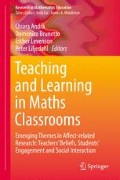Abstract
Patterning activities, specifically those related to repeating patterns, may encourage young children’s appreciation for underlying structures. This paper investigates preschool teachers’ knowledge and self-efficacy for defining, drawing, and continuing repeating patterns. Results indicated that teachers were able to draw and continue various repeating patterns but had difficulties defining repeating patterns. In general, teachers had a high self-efficacy for all tasks. However, teachers’ had a significantly lower self-efficacy for defining repeating patterns than for drawing and continuing repeating patterns.
Access this chapter
Tax calculation will be finalised at checkout
Purchases are for personal use only
References
Bandura, A., & Schunk, G. H. (1981). Cultivating competence, self-efficacy, and intrinsic interest through proximal self-motivation. Journal of Personality and Social Psychology, 41(3), 586–598.
Bates, A. B., Latham, N., & Kim, J. (2011). Linking preservice teachers’ mathematics self-efficacy and mathematics teaching efficacy to their mathematical performance. School Science and Mathematics, 111(7), 325–333.
Clarke, D. M., & Clarke, B. A. (2004). Mathematics teaching in Grades K-2: Painting a picture of challenging, supportive, and effective classrooms. In R. N. Rubenstein & G. W. Bright (Eds.), Perspectives on the teaching of mathematics (pp. 67–81). Reston: NCTM.
Fox, J. (2005). Child-initiated mathematical patterning in the pre-compulsory years. In H. L. Chick & J. L. Vincent (Eds.), Proceedings of the 29th Conference for the Psychology of Mathematics Education (Vol. 2, pp. 313–320). Melbourne: PME.
Hackett, G., & Betz, N. (1989). An exploration of the mathematics self-efficacy/mathematics performance correspondence. Journal for Research in Mathematics Education, 20, 261–273.
Israel National Mathematics Preschool Curriculum (INMPC). (2008). Retrieved from http://meyda.education.gov.il/files/Tochniyot_Limudim/KdamYesodi/Math1.pdf
Klibanoff, R. S., Levine, S. C., Huttenlocher, J., Vasilyeva, M., & Hedges, L. V. (2006). Preschool children’s mathematical knowledge: The effect of teacher “math talk”. Developmental Psychology, 42(1), 59.
National Council of Teachers of Mathematics. (2000). Principles and standards for school mathematics. Reston: NCTM.
Papic, M., Mulligan, J., & Mitchelmore, M. (2011). Assessing the development of preschoolers’ mathematical patterning. Journal for Research in Mathematics Education, 42(3), 237–269.
Rittle-Johnson, B., Fyfe, E. R., McLean, L. E., & McEldoon, K. L. (2013). Emerging understanding of patterning in 4-year-olds. Journal of Cognition and Development, 14(3), 376–396.
Schoenfeld, A. H. (1992). Learning to think mathematically: Problem solving, metacognition, and sense-making in mathematics. In D. Grouws (Ed.), Handbook of research on mathematics teaching and learning (pp. 334–370). New York: Macmillan.
Seo, K. H., & Ginsburg, H. P. (2004). What is developmentally appropriate in early childhood mathematics education? Lessons from new research. In D. H. Clements, J. Sarama, & A.-M. DiBiase (Eds.), Engaging young children in mathematics: Standards for early childhood mathematics education (pp. 91–104). Mahwah: Erlbaum.
Starkey, P., Klein, A., & Wakeley, A. (2004). Enhancing young children’s mathematical knowledge through a pre-kindergarten mathematics intervention. Early Childhood Research Quarterly, 19(1), 99–120.
Tirosh, D., Tsamir, P., Levenson, E., Tabach, M., & Barkai, R. (2014). Preschool teachers’ self-efficacy and knowledge for defining and identifying triangles and circles. In L. Sumpter (Ed.), Proceedings of the MAVI-20 Conference, September 29–October 1, 2014, Falun, Sweden (pp. 181–191). Falun: Dalarna University.
Tsamir, P., Tirosh, D., Levenson, E., Tabach, M., & Barkai, R. (2015). Preschool teachers’ knowledge and self-efficacy needed for teaching geometry: Are they related? In B. Pepin & B. Rösken-Winter (Eds.), From beliefs to dynamic affect systems–(exploring) a mosaic of relationships and interactions (pp. 319–337). Cham: Springer.
Zazkis, R., & Liljedahl, P. (2006). On the path to number theory: Repeating patterns as a gateway. In R. Zazkis & S. R. Campbell (Eds.), Number theory in mathematics education: Perspectives and prospects (pp. 99–114). Mahwah: Erlbaum.
Acknowledgements
This research was supported by The Israel Science Foundation (grant No. 1270/14).
Author information
Authors and Affiliations
Corresponding author
Editor information
Editors and Affiliations
Rights and permissions
Copyright information
© 2017 Springer International Publishing AG
About this chapter
Cite this chapter
Tirosh, D., Tsamir, P., Levenson, E., Barkai, R., Tabach, M. (2017). Defining, Drawing, and Continuing Repeating Patterns: Preschool Teachers’ Self-efficacy and Knowledge. In: Andrà, C., Brunetto, D., Levenson, E., Liljedahl, P. (eds) Teaching and Learning in Maths Classrooms. Research in Mathematics Education. Springer, Cham. https://doi.org/10.1007/978-3-319-49232-2_3
Download citation
DOI: https://doi.org/10.1007/978-3-319-49232-2_3
Published:
Publisher Name: Springer, Cham
Print ISBN: 978-3-319-49231-5
Online ISBN: 978-3-319-49232-2
eBook Packages: EducationEducation (R0)

